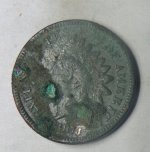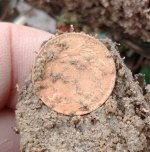kenb
Bronze Member
Truth about gold bars still a good mystery
By Phil Brown, Commentary
Brad Clover, of Enid, has some evidence a major operation was under way in the late 1930s or maybe early ’40s to locate 14 gold bars said to have been buried in the vicinity of the dam at the Great Salt Plains Lake 158 years ago by five men engaged in what must have been a running fight with a band of hostile Cheyenne-Arapaho Indians.
Some versions of the story, which I related in an earlier column, tell about efforts to locate the bars in later years. Apparently they were never found. Clover has a photo of the search operations that were under way. The photo is small and was taken from a distance, and is dark. It appears to have been taken with a box camera. Clover got it from his mother.
Close examination of the picture does show what appears to be a major drilling project with a small rig. There also appears to be a drilling pit around the rig. One version of the story says Carl Sheldon, one of the survivors of the Indian raid, returned in 1901 to retrieve the treasure, but didn’t find it. Associates of his continued the search into the 1940s.
Clover’s photo is apparently of the people who were still looking in the 1930s, but who did not find it either. At least we guess they didn’t find it. There is no evidence they did. If they had found the gold it would have been difficult to keep it a secret. Trying to dispose of 14 gold bars would have attracted a lot of attention. They had to abandon the hunt because of construction on the dam that created Great Salt Plains Lake.
But it’s apparent in the small photo this was not just a couple of guys with a treasure map and an auger poking holes in the ground at random. It was a sophisticated drilling outfit, and they must have believed the gold — wrapped in a buffalo hide — was down there somewhere.
I’ve never heard positively where the gold came from in the first place. I speculated because of the date — 1850 — the five guys got lucky in the 1849 California gold rush and were returning home to Missouri with their earnings when they bumped into the Indians, but that is just a guess.
Somebody believed the gold was really down there in the shifting sands of Great Salt Plains, because they were still poking around trying to find it 90 years after the Indian attack.
There is more than one mystery here. Why did Sheldon wait 50 years to come looking for it? Did the other guy who escaped with him come back alone and retrieve the gold — or most of it? And, where did the gold really come from? Was it stolen?
There must surely be some kind of modern technology — maybe some kind of fancy radar that can look down through the water, the fish and the mud and see if there are 14 gold bars down there somewhere near the dam. Anything as dense as gold should be easily detected by radar, right?
Of course I don’t know what the 14 gold bars weighed, so I can’t really say what they would be worth at today’s inflated prices. If we (you and me) want to assume the 14 bars weighed about 400 pounds, that would be 6,400 ounces, and on the futures market gold is being quoted at about $881 an ounce — that means the gold bars might be worth about $5.6 million.
By today’s standards that is not a huge fortune, but there is just something about buried treasure and Indians, and of course everyone loves a good mystery.
n
Well, it is once again time to remember a northwest Oklahoma town was the only municipality in the lower 48 states bombed during World War II.
It was shortly after midnight on July 5, 1943, bombs fell on Boise City, in Cimarron County out in the Oklahoma Panhandle. A low flying aircraft rained six bombs on the sleeping town.
They were practice bombs though, and resulted in slight damage to the Baptist Church and the Bourke Garage.
No one was injured, and some people were not even awakened by the practice bombs. They didn’t make much noise.
All of the bombs were dropped by one aircraft — a B-25 from the Dalhart Army Air Field in Texas. The plane was supposed to drop its bombs on a lighted practice target near Conlen, Texas, 30 miles south of Boise City.
Ironically the lighted target was a square with a light on each of the four corners, and the town square at Boise City was one block square with a street light on each of the four corners, hence the mixup, I guess.
The bombs quit falling when someone had the bright idea to hit the master switch, plunging Boise City into darkness.
Needless to say Army brass descended on the town the next morning to assess the damage and offer their most sincere apologies.
kenb
By Phil Brown, Commentary
Brad Clover, of Enid, has some evidence a major operation was under way in the late 1930s or maybe early ’40s to locate 14 gold bars said to have been buried in the vicinity of the dam at the Great Salt Plains Lake 158 years ago by five men engaged in what must have been a running fight with a band of hostile Cheyenne-Arapaho Indians.
Some versions of the story, which I related in an earlier column, tell about efforts to locate the bars in later years. Apparently they were never found. Clover has a photo of the search operations that were under way. The photo is small and was taken from a distance, and is dark. It appears to have been taken with a box camera. Clover got it from his mother.
Close examination of the picture does show what appears to be a major drilling project with a small rig. There also appears to be a drilling pit around the rig. One version of the story says Carl Sheldon, one of the survivors of the Indian raid, returned in 1901 to retrieve the treasure, but didn’t find it. Associates of his continued the search into the 1940s.
Clover’s photo is apparently of the people who were still looking in the 1930s, but who did not find it either. At least we guess they didn’t find it. There is no evidence they did. If they had found the gold it would have been difficult to keep it a secret. Trying to dispose of 14 gold bars would have attracted a lot of attention. They had to abandon the hunt because of construction on the dam that created Great Salt Plains Lake.
But it’s apparent in the small photo this was not just a couple of guys with a treasure map and an auger poking holes in the ground at random. It was a sophisticated drilling outfit, and they must have believed the gold — wrapped in a buffalo hide — was down there somewhere.
I’ve never heard positively where the gold came from in the first place. I speculated because of the date — 1850 — the five guys got lucky in the 1849 California gold rush and were returning home to Missouri with their earnings when they bumped into the Indians, but that is just a guess.
Somebody believed the gold was really down there in the shifting sands of Great Salt Plains, because they were still poking around trying to find it 90 years after the Indian attack.
There is more than one mystery here. Why did Sheldon wait 50 years to come looking for it? Did the other guy who escaped with him come back alone and retrieve the gold — or most of it? And, where did the gold really come from? Was it stolen?
There must surely be some kind of modern technology — maybe some kind of fancy radar that can look down through the water, the fish and the mud and see if there are 14 gold bars down there somewhere near the dam. Anything as dense as gold should be easily detected by radar, right?
Of course I don’t know what the 14 gold bars weighed, so I can’t really say what they would be worth at today’s inflated prices. If we (you and me) want to assume the 14 bars weighed about 400 pounds, that would be 6,400 ounces, and on the futures market gold is being quoted at about $881 an ounce — that means the gold bars might be worth about $5.6 million.
By today’s standards that is not a huge fortune, but there is just something about buried treasure and Indians, and of course everyone loves a good mystery.
n
Well, it is once again time to remember a northwest Oklahoma town was the only municipality in the lower 48 states bombed during World War II.
It was shortly after midnight on July 5, 1943, bombs fell on Boise City, in Cimarron County out in the Oklahoma Panhandle. A low flying aircraft rained six bombs on the sleeping town.
They were practice bombs though, and resulted in slight damage to the Baptist Church and the Bourke Garage.
No one was injured, and some people were not even awakened by the practice bombs. They didn’t make much noise.
All of the bombs were dropped by one aircraft — a B-25 from the Dalhart Army Air Field in Texas. The plane was supposed to drop its bombs on a lighted practice target near Conlen, Texas, 30 miles south of Boise City.
Ironically the lighted target was a square with a light on each of the four corners, and the town square at Boise City was one block square with a street light on each of the four corners, hence the mixup, I guess.
The bombs quit falling when someone had the bright idea to hit the master switch, plunging Boise City into darkness.
Needless to say Army brass descended on the town the next morning to assess the damage and offer their most sincere apologies.
kenb


 ?
?


